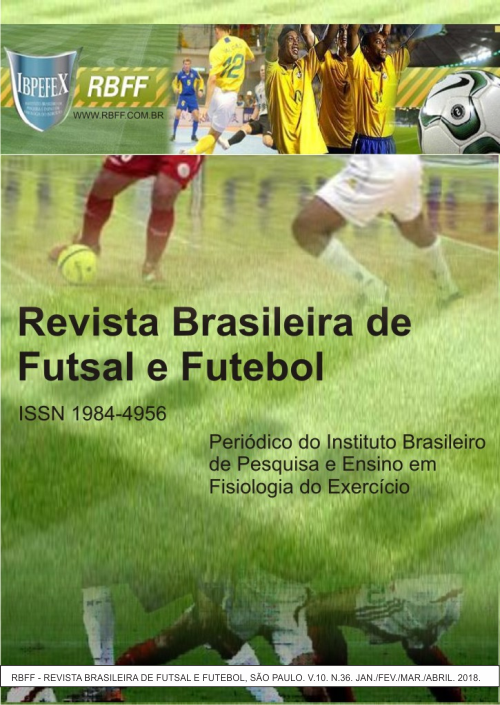Physical activity and humor: the case of pick-up football game in the club AABB Goiânia
Abstract
This study aimed to analyze how the recreational activity influenced the mood levels of pick-up football game practitioners in a private club in Goiânia, the AABB (Associação Brasileira do Banco do Brasil) club. The sample consisted of 85 males aged between 40 and 75 years, mean age 53 ± 7.32 years. The instrument used to measure the mood of the practitioners was BRUMS. The application of the mood test occurred before and after the pick-up football game, to identify the variation of the mood level of the subjects. For the data analysis, descriptive statistics were used to verify the mean and standard deviation, in addition to the ShapiroWilk tests to verify the normality of the data. As for inferential statistics, considering that the data presented a normal distribution, the variation of the mood state was compared by means of the t-paired test and the significance level adopted was 5% (p≤0.05). For statistical analysis SPSS software 20.0 was used. The results showed that practitioners of pick-up football game were more fatigued, angrier and less vigorous (p <0.05). In this context, it can be concluded that pick-up football game can bring significant changes of mood, mainly in the analysis of factors that are related to the physical condition of the practitioner, as well as anger.
References
-Allen, J.B.; Jong, M.R. Sailing and sports medicine: a literature review. British JournalSports Medicine.Vol. 40. Num. 7. 2006. p. 587-593.
-Berger, B.G.; Molt, R.W. Exercise and Mood: A Selective Review and Synthesis of Research Employing the Profile of Mood States. Journal of Applied Sport Psychology. Vol. 12. 2000.
-Bertollo, M.; Saltarelli, B.; Robazza, C. Mental preparation strategies of elite modern pentathletes. Psychology ofSports and Exercise. Vol. 10. Num. 2. 2009. p. 244-254.
-Brandt, R.; Viana, M.S.; Segato, L; Andrade, A. Estados de humor de velejadores durante o Pré-Panamericano. Motriz. Vol. 16. Num. 4. 2010. p. 834-840.
-Duarte, R.B. Valoración de parámetros psicossociales em La selección de talentos para el deporte de velas. Revista Digital Buenos Aires. Num. 73. 2004.
-Lane, A. M.; Terry, P. C. The nature of mood: development of a conceptual model with a Focus on depression. Journal Applied Sports Psychology. Vol. 12. Num. 1. 2001. p. 16-33.
-Lane, A. M.; Whyte, G.P.; Terry, P.C.; Nevill, A.M. Mood, self-set goals and examination performance: the moderating effect of depressed mood. Personality and Individual Differences. Vol. 39. Num. 1. 2005. p. 143-153.
-Mcardle, W.D.; Katch, F.I.; Katch, V.L. Fisiologia do exercício: energia, nutrição e desempenho humano. Rio de Janeiro. Guanabara Koogan. 1998. p. 333.
-Nunomura, M.; Teixeira, L.A.C.; Caruso, M.R.F. Nível de Estresse em Adultos após 12 Meses de Prática Regular de Atividade Física. Revista Mackenzie de Educação Física e Esporte. Vol. 3. 2004. p. 125-134.
-Rohlfs, I.C.P.M. Validação do Teste Brums para Avaliação de Humor em Atletas e Não Atletas Brasileiros. Dissertação de Mestrado. UDESC-SC. 2006. p. 17-54.
-Rohlfs, I.C.P.M.; Carvalho, T.; Rotta, T.M.; Krebs, R.J. Aplicação de instrumentos de avaliação de estados de humor na detecção da síndrome do excesso de treinamento. Revista Brasileira de Medicina do Esporte. Vol. 10. Num. 2. 2004. p. 111-116.
-Rohlfs, I.C.P.M.; Rotta, T.M.; Luft, C.B.; Andrade, A.; Krebs, R.J.; Carvalho, T. A Escala de Humor de Brunel (BRUMS): instrumento para detecção precoce da síndrome do excesso de treinamento. Revista Brasileia de Medicina do Esporte. Vol. 14. Num. 3. 2008.
-Rossi, L.; Tirapegui, J. Aspectos atuais sobre exercício físico, fadiga e nutrição. Revista Paulista de Educação Física. Vol. 13. Num. 1. 1999. p. 67-82.
-Rotta, T.M.; Rohlfs, I.C.P.M.; Oliveira, W.F. Aplicabilidade do Brums: estados de humor em atletas de voleibol e tênis no alto rendimento. Revista Brasileira de Medicina do Esporte. Vol. 20. Num. 6. 2014.
-Silva, A.B.E.; Chaveiro, E.F. Jogo De Bola: Uma Análise Socioespacial Dos Territórios Dos Peladeiros. Revista Pensar a Prática. Vol. 10. Num. 1. 2007.
-Terry, P.C. The efficacy of mood state profiling among elite performers: A review and synthesis. The Sport Psychologist. Champaign. Vol. 9. 1995. p. 309-324.
-Terry, P. C.; Lane, A. M.; Fogarty, G. J. Construct validity of the Profile of Mood States -Adolescents for use with adults. Psychology of Sport and Exercise. Vol. 4. Num. 2. 2003. p. 125-139.
-Werneck, F.Z.; Filho, M. G. B.; Ribeiro, L. C. S. Efeitos do Exercício Físico sobre os Estados de Humor: Uma Revisão. Revista Brasileira de Psicologia do Esporte e do Exercício. 2006. p. 22-54.
-Werneck, F. Z. Nível de Atividade Física e Estado de Humor em Adolescentes. Revista de Psicologia: Teoria e Pesquisa. Vol. 27. Num. 2. 2011. p. 189-193.
Authors who publish in this journal agree to the following terms:
- Authors retain the copyright and grant the journal the right of first publication, with work simultaneously licensed under the Creative Commons Attribution License BY-NC which allows the sharing of the work with acknowledgment of the authorship of the work and initial publication in this journal.
- Authors are authorized to enter into additional contracts separately for non-exclusive distribution of the version of the work published in this journal (eg, publishing in institutional repository or book chapter), with acknowledgment of authorship and initial publication in this journal.
- Authors are allowed and encouraged to post and distribute their work online (eg, in institutional repositories or on their personal page) at any point before or during the editorial process, as this can bring about productive change as well as increase impact and impact. citation of published work (See The Effect of Free Access).





